Marketing Plan for an Australian Fashion Industry Enterprise Report
VerifiedAdded on 2022/12/23
|12
|3039
|47
Report
AI Summary
This report presents a comprehensive marketing plan for an Australian fashion industry enterprise facing declining market share. The report begins with an introduction to the Australian fashion industry and the enterprise's current situation, followed by recommendations for introducing new product lines: sustainable fashion, sports apparel and footwear, and luxury apparel. It then details the research methodology, including the use of secondary data sources. The core of the report focuses on segmenting, targeting, and positioning strategies for each product line, along with an indicative marketing mix. The report also identifies potential risks associated with each product line and suggests mitigation strategies. The target market for luxury apparel is affluent women aged 28-45, while sports apparel targets affluent men aged 18-35. Sustainable fashion targets individuals aged 45-59. The report aims to provide a detailed marketing plan to improve the enterprise's market position.
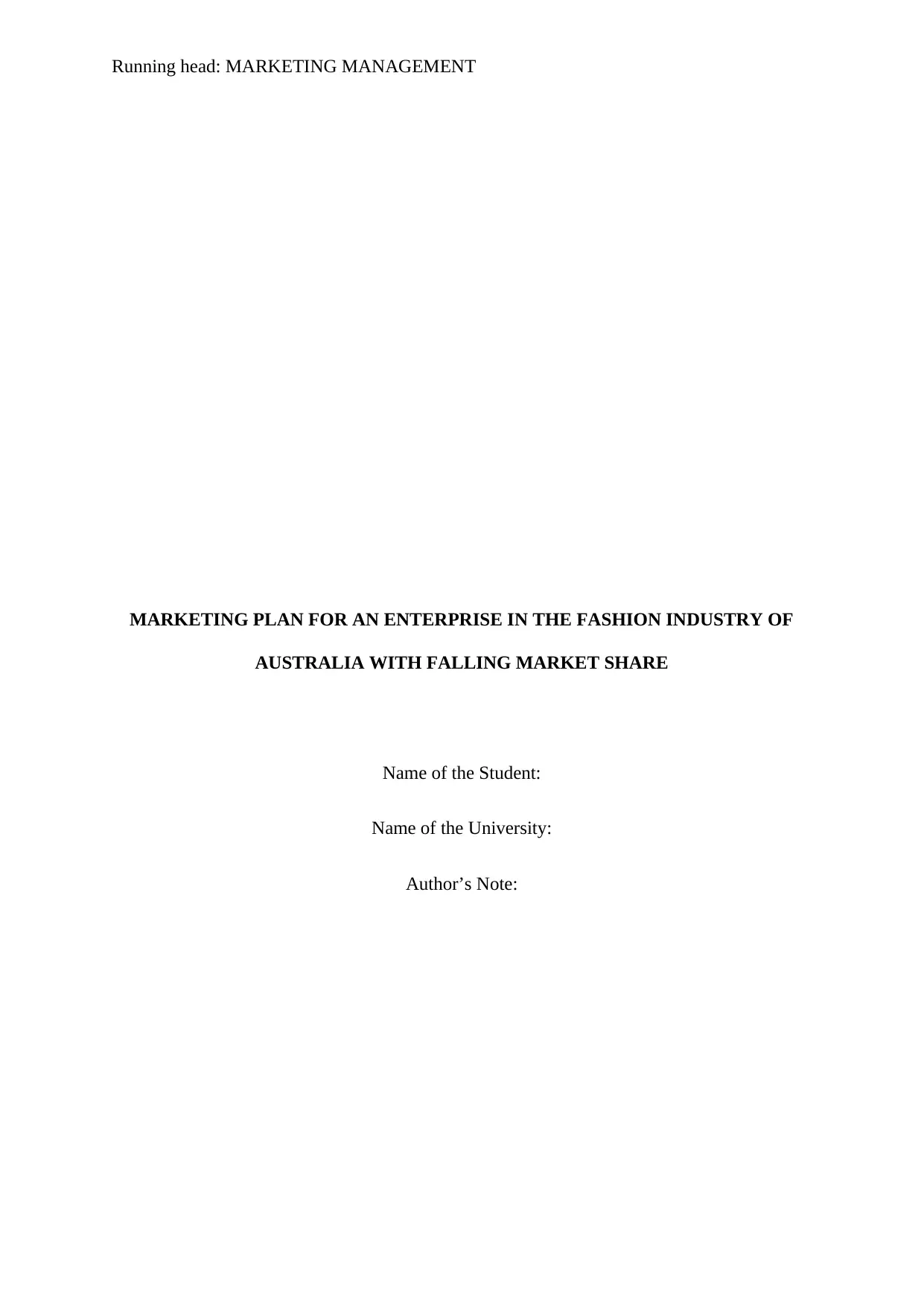
Running head: MARKETING MANAGEMENT
MARKETING PLAN FOR AN ENTERPRISE IN THE FASHION INDUSTRY OF
AUSTRALIA WITH FALLING MARKET SHARE
Name of the Student:
Name of the University:
Author’s Note:
MARKETING PLAN FOR AN ENTERPRISE IN THE FASHION INDUSTRY OF
AUSTRALIA WITH FALLING MARKET SHARE
Name of the Student:
Name of the University:
Author’s Note:
Paraphrase This Document
Need a fresh take? Get an instant paraphrase of this document with our AI Paraphraser
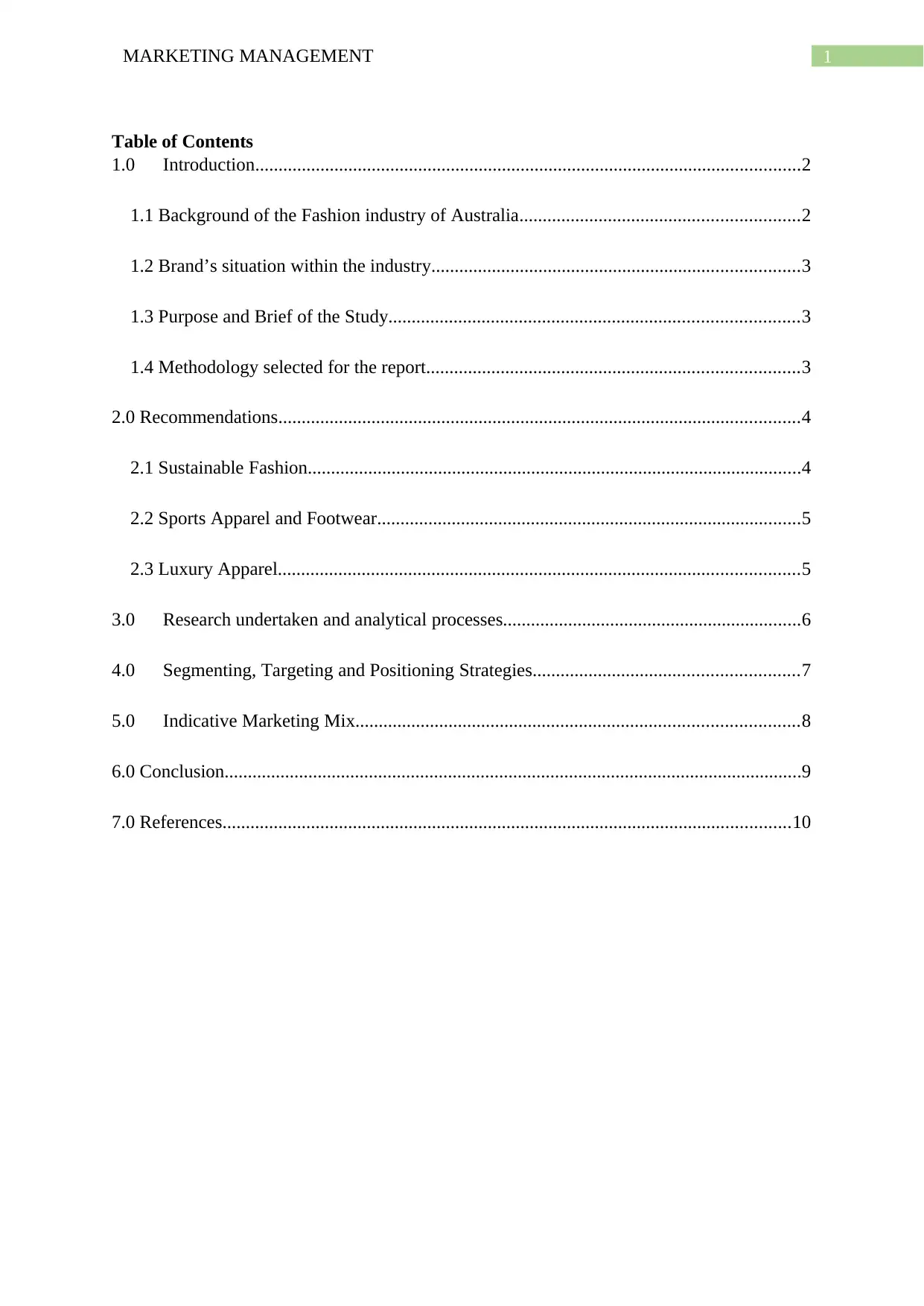
1MARKETING MANAGEMENT
Table of Contents
1.0 Introduction.....................................................................................................................2
1.1 Background of the Fashion industry of Australia............................................................2
1.2 Brand’s situation within the industry...............................................................................3
1.3 Purpose and Brief of the Study........................................................................................3
1.4 Methodology selected for the report................................................................................3
2.0 Recommendations................................................................................................................4
2.1 Sustainable Fashion..........................................................................................................4
2.2 Sports Apparel and Footwear...........................................................................................5
2.3 Luxury Apparel................................................................................................................5
3.0 Research undertaken and analytical processes................................................................6
4.0 Segmenting, Targeting and Positioning Strategies.........................................................7
5.0 Indicative Marketing Mix...............................................................................................8
6.0 Conclusion............................................................................................................................9
7.0 References..........................................................................................................................10
Table of Contents
1.0 Introduction.....................................................................................................................2
1.1 Background of the Fashion industry of Australia............................................................2
1.2 Brand’s situation within the industry...............................................................................3
1.3 Purpose and Brief of the Study........................................................................................3
1.4 Methodology selected for the report................................................................................3
2.0 Recommendations................................................................................................................4
2.1 Sustainable Fashion..........................................................................................................4
2.2 Sports Apparel and Footwear...........................................................................................5
2.3 Luxury Apparel................................................................................................................5
3.0 Research undertaken and analytical processes................................................................6
4.0 Segmenting, Targeting and Positioning Strategies.........................................................7
5.0 Indicative Marketing Mix...............................................................................................8
6.0 Conclusion............................................................................................................................9
7.0 References..........................................................................................................................10
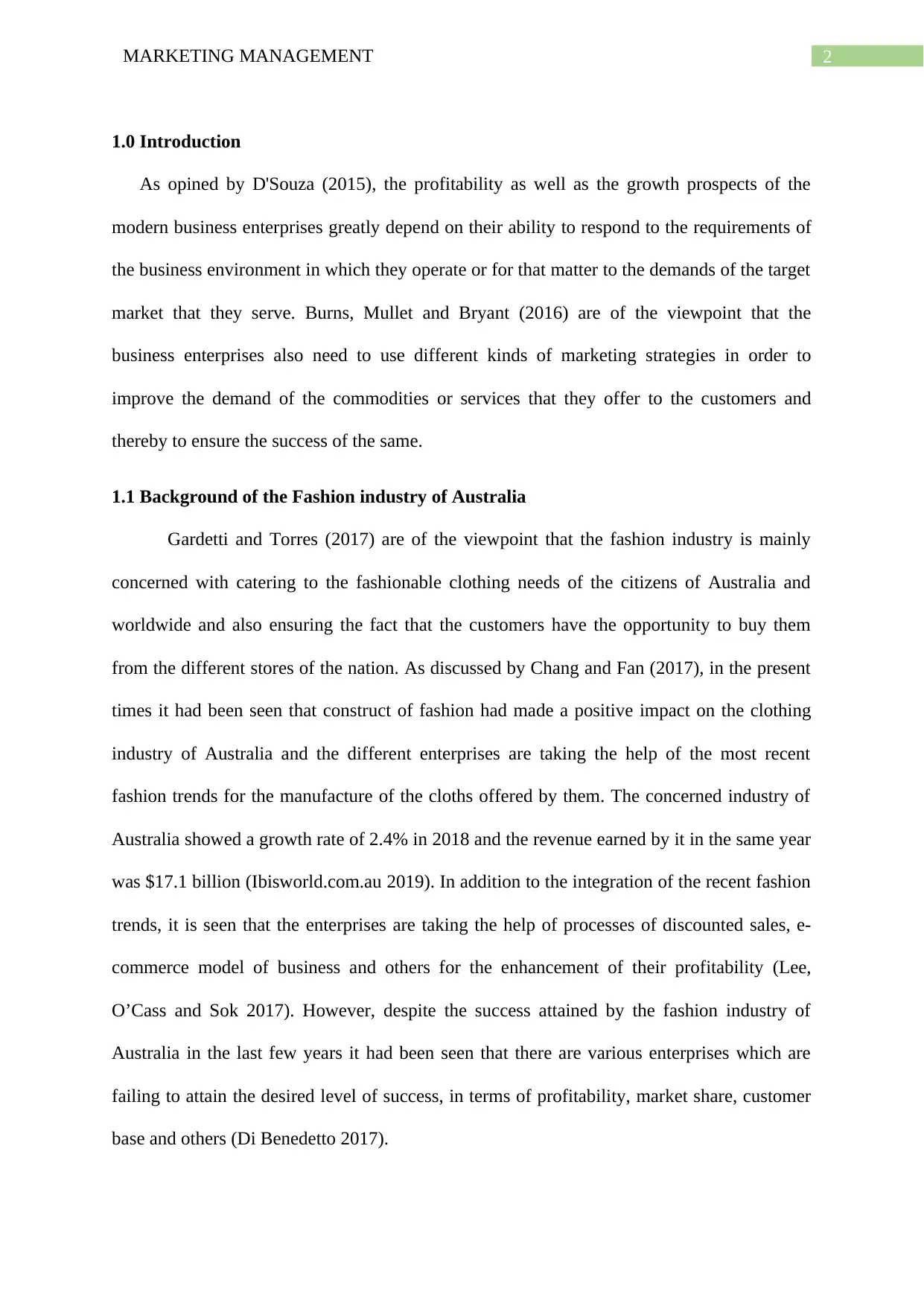
2MARKETING MANAGEMENT
1.0 Introduction
As opined by D'Souza (2015), the profitability as well as the growth prospects of the
modern business enterprises greatly depend on their ability to respond to the requirements of
the business environment in which they operate or for that matter to the demands of the target
market that they serve. Burns, Mullet and Bryant (2016) are of the viewpoint that the
business enterprises also need to use different kinds of marketing strategies in order to
improve the demand of the commodities or services that they offer to the customers and
thereby to ensure the success of the same.
1.1 Background of the Fashion industry of Australia
Gardetti and Torres (2017) are of the viewpoint that the fashion industry is mainly
concerned with catering to the fashionable clothing needs of the citizens of Australia and
worldwide and also ensuring the fact that the customers have the opportunity to buy them
from the different stores of the nation. As discussed by Chang and Fan (2017), in the present
times it had been seen that construct of fashion had made a positive impact on the clothing
industry of Australia and the different enterprises are taking the help of the most recent
fashion trends for the manufacture of the cloths offered by them. The concerned industry of
Australia showed a growth rate of 2.4% in 2018 and the revenue earned by it in the same year
was $17.1 billion (Ibisworld.com.au 2019). In addition to the integration of the recent fashion
trends, it is seen that the enterprises are taking the help of processes of discounted sales, e-
commerce model of business and others for the enhancement of their profitability (Lee,
O’Cass and Sok 2017). However, despite the success attained by the fashion industry of
Australia in the last few years it had been seen that there are various enterprises which are
failing to attain the desired level of success, in terms of profitability, market share, customer
base and others (Di Benedetto 2017).
1.0 Introduction
As opined by D'Souza (2015), the profitability as well as the growth prospects of the
modern business enterprises greatly depend on their ability to respond to the requirements of
the business environment in which they operate or for that matter to the demands of the target
market that they serve. Burns, Mullet and Bryant (2016) are of the viewpoint that the
business enterprises also need to use different kinds of marketing strategies in order to
improve the demand of the commodities or services that they offer to the customers and
thereby to ensure the success of the same.
1.1 Background of the Fashion industry of Australia
Gardetti and Torres (2017) are of the viewpoint that the fashion industry is mainly
concerned with catering to the fashionable clothing needs of the citizens of Australia and
worldwide and also ensuring the fact that the customers have the opportunity to buy them
from the different stores of the nation. As discussed by Chang and Fan (2017), in the present
times it had been seen that construct of fashion had made a positive impact on the clothing
industry of Australia and the different enterprises are taking the help of the most recent
fashion trends for the manufacture of the cloths offered by them. The concerned industry of
Australia showed a growth rate of 2.4% in 2018 and the revenue earned by it in the same year
was $17.1 billion (Ibisworld.com.au 2019). In addition to the integration of the recent fashion
trends, it is seen that the enterprises are taking the help of processes of discounted sales, e-
commerce model of business and others for the enhancement of their profitability (Lee,
O’Cass and Sok 2017). However, despite the success attained by the fashion industry of
Australia in the last few years it had been seen that there are various enterprises which are
failing to attain the desired level of success, in terms of profitability, market share, customer
base and others (Di Benedetto 2017).
⊘ This is a preview!⊘
Do you want full access?
Subscribe today to unlock all pages.

Trusted by 1+ million students worldwide
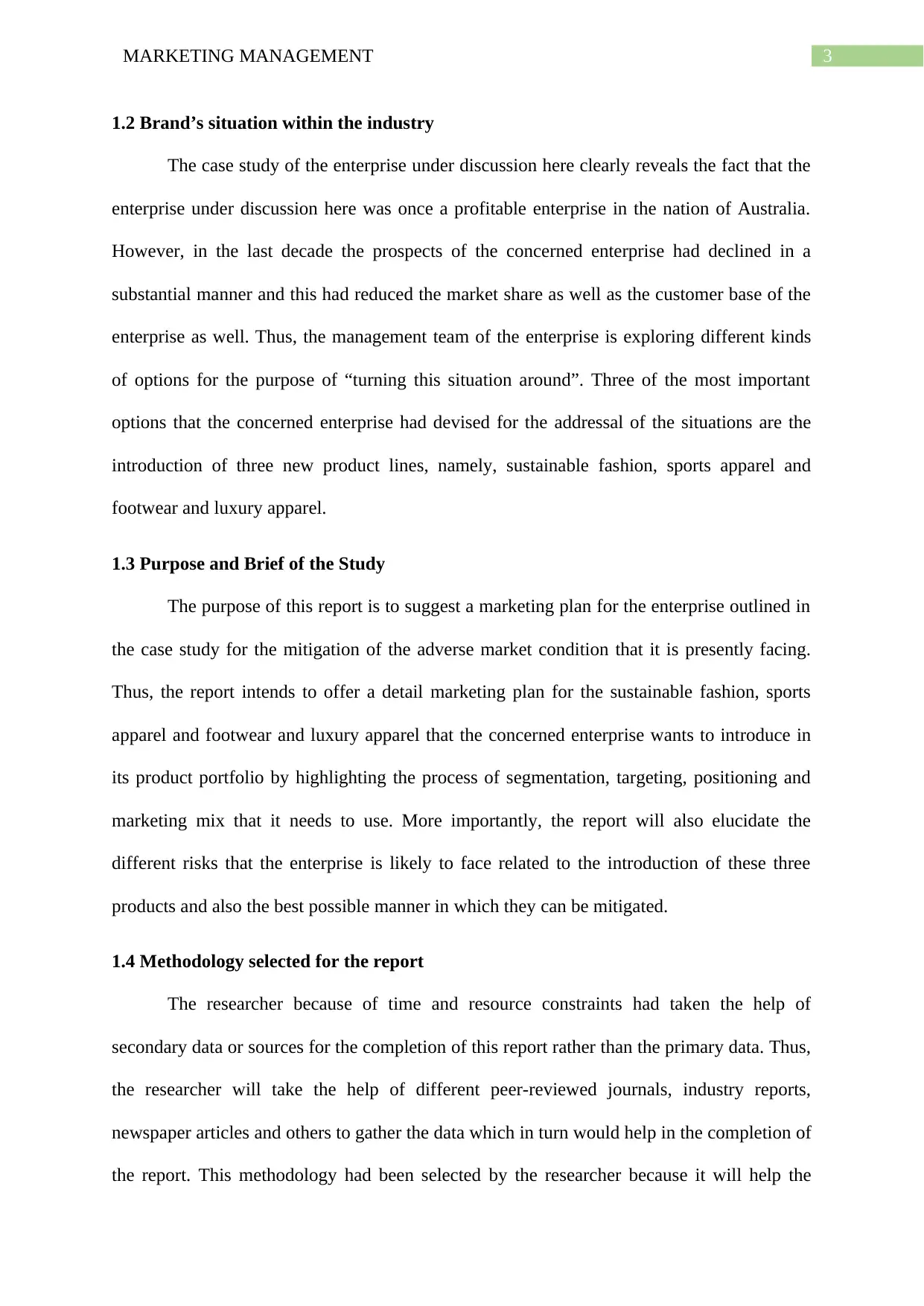
3MARKETING MANAGEMENT
1.2 Brand’s situation within the industry
The case study of the enterprise under discussion here clearly reveals the fact that the
enterprise under discussion here was once a profitable enterprise in the nation of Australia.
However, in the last decade the prospects of the concerned enterprise had declined in a
substantial manner and this had reduced the market share as well as the customer base of the
enterprise as well. Thus, the management team of the enterprise is exploring different kinds
of options for the purpose of “turning this situation around”. Three of the most important
options that the concerned enterprise had devised for the addressal of the situations are the
introduction of three new product lines, namely, sustainable fashion, sports apparel and
footwear and luxury apparel.
1.3 Purpose and Brief of the Study
The purpose of this report is to suggest a marketing plan for the enterprise outlined in
the case study for the mitigation of the adverse market condition that it is presently facing.
Thus, the report intends to offer a detail marketing plan for the sustainable fashion, sports
apparel and footwear and luxury apparel that the concerned enterprise wants to introduce in
its product portfolio by highlighting the process of segmentation, targeting, positioning and
marketing mix that it needs to use. More importantly, the report will also elucidate the
different risks that the enterprise is likely to face related to the introduction of these three
products and also the best possible manner in which they can be mitigated.
1.4 Methodology selected for the report
The researcher because of time and resource constraints had taken the help of
secondary data or sources for the completion of this report rather than the primary data. Thus,
the researcher will take the help of different peer-reviewed journals, industry reports,
newspaper articles and others to gather the data which in turn would help in the completion of
the report. This methodology had been selected by the researcher because it will help the
1.2 Brand’s situation within the industry
The case study of the enterprise under discussion here clearly reveals the fact that the
enterprise under discussion here was once a profitable enterprise in the nation of Australia.
However, in the last decade the prospects of the concerned enterprise had declined in a
substantial manner and this had reduced the market share as well as the customer base of the
enterprise as well. Thus, the management team of the enterprise is exploring different kinds
of options for the purpose of “turning this situation around”. Three of the most important
options that the concerned enterprise had devised for the addressal of the situations are the
introduction of three new product lines, namely, sustainable fashion, sports apparel and
footwear and luxury apparel.
1.3 Purpose and Brief of the Study
The purpose of this report is to suggest a marketing plan for the enterprise outlined in
the case study for the mitigation of the adverse market condition that it is presently facing.
Thus, the report intends to offer a detail marketing plan for the sustainable fashion, sports
apparel and footwear and luxury apparel that the concerned enterprise wants to introduce in
its product portfolio by highlighting the process of segmentation, targeting, positioning and
marketing mix that it needs to use. More importantly, the report will also elucidate the
different risks that the enterprise is likely to face related to the introduction of these three
products and also the best possible manner in which they can be mitigated.
1.4 Methodology selected for the report
The researcher because of time and resource constraints had taken the help of
secondary data or sources for the completion of this report rather than the primary data. Thus,
the researcher will take the help of different peer-reviewed journals, industry reports,
newspaper articles and others to gather the data which in turn would help in the completion of
the report. This methodology had been selected by the researcher because it will help the
Paraphrase This Document
Need a fresh take? Get an instant paraphrase of this document with our AI Paraphraser
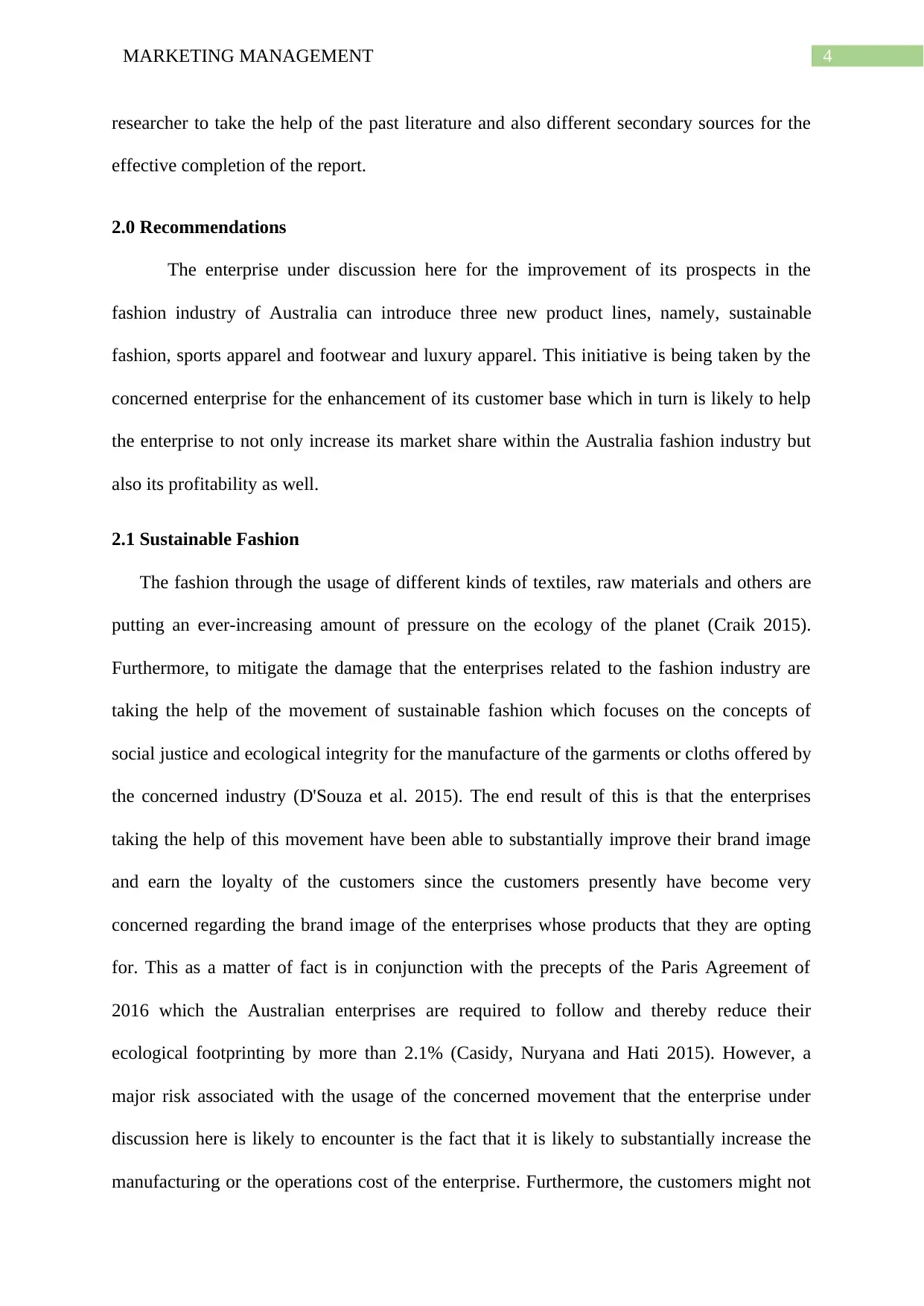
4MARKETING MANAGEMENT
researcher to take the help of the past literature and also different secondary sources for the
effective completion of the report.
2.0 Recommendations
The enterprise under discussion here for the improvement of its prospects in the
fashion industry of Australia can introduce three new product lines, namely, sustainable
fashion, sports apparel and footwear and luxury apparel. This initiative is being taken by the
concerned enterprise for the enhancement of its customer base which in turn is likely to help
the enterprise to not only increase its market share within the Australia fashion industry but
also its profitability as well.
2.1 Sustainable Fashion
The fashion through the usage of different kinds of textiles, raw materials and others are
putting an ever-increasing amount of pressure on the ecology of the planet (Craik 2015).
Furthermore, to mitigate the damage that the enterprises related to the fashion industry are
taking the help of the movement of sustainable fashion which focuses on the concepts of
social justice and ecological integrity for the manufacture of the garments or cloths offered by
the concerned industry (D'Souza et al. 2015). The end result of this is that the enterprises
taking the help of this movement have been able to substantially improve their brand image
and earn the loyalty of the customers since the customers presently have become very
concerned regarding the brand image of the enterprises whose products that they are opting
for. This as a matter of fact is in conjunction with the precepts of the Paris Agreement of
2016 which the Australian enterprises are required to follow and thereby reduce their
ecological footprinting by more than 2.1% (Casidy, Nuryana and Hati 2015). However, a
major risk associated with the usage of the concerned movement that the enterprise under
discussion here is likely to encounter is the fact that it is likely to substantially increase the
manufacturing or the operations cost of the enterprise. Furthermore, the customers might not
researcher to take the help of the past literature and also different secondary sources for the
effective completion of the report.
2.0 Recommendations
The enterprise under discussion here for the improvement of its prospects in the
fashion industry of Australia can introduce three new product lines, namely, sustainable
fashion, sports apparel and footwear and luxury apparel. This initiative is being taken by the
concerned enterprise for the enhancement of its customer base which in turn is likely to help
the enterprise to not only increase its market share within the Australia fashion industry but
also its profitability as well.
2.1 Sustainable Fashion
The fashion through the usage of different kinds of textiles, raw materials and others are
putting an ever-increasing amount of pressure on the ecology of the planet (Craik 2015).
Furthermore, to mitigate the damage that the enterprises related to the fashion industry are
taking the help of the movement of sustainable fashion which focuses on the concepts of
social justice and ecological integrity for the manufacture of the garments or cloths offered by
the concerned industry (D'Souza et al. 2015). The end result of this is that the enterprises
taking the help of this movement have been able to substantially improve their brand image
and earn the loyalty of the customers since the customers presently have become very
concerned regarding the brand image of the enterprises whose products that they are opting
for. This as a matter of fact is in conjunction with the precepts of the Paris Agreement of
2016 which the Australian enterprises are required to follow and thereby reduce their
ecological footprinting by more than 2.1% (Casidy, Nuryana and Hati 2015). However, a
major risk associated with the usage of the concerned movement that the enterprise under
discussion here is likely to encounter is the fact that it is likely to substantially increase the
manufacturing or the operations cost of the enterprise. Furthermore, the customers might not
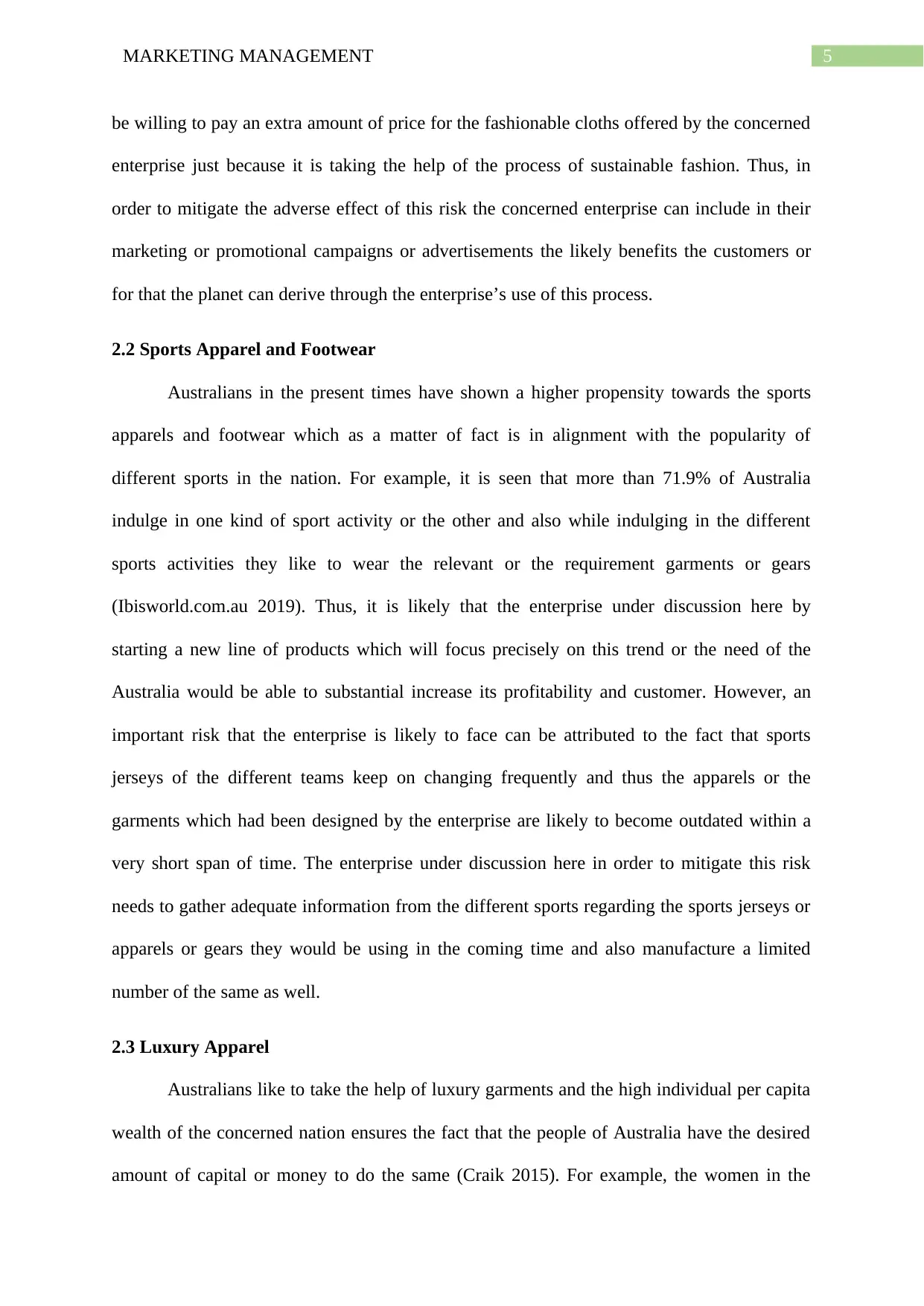
5MARKETING MANAGEMENT
be willing to pay an extra amount of price for the fashionable cloths offered by the concerned
enterprise just because it is taking the help of the process of sustainable fashion. Thus, in
order to mitigate the adverse effect of this risk the concerned enterprise can include in their
marketing or promotional campaigns or advertisements the likely benefits the customers or
for that the planet can derive through the enterprise’s use of this process.
2.2 Sports Apparel and Footwear
Australians in the present times have shown a higher propensity towards the sports
apparels and footwear which as a matter of fact is in alignment with the popularity of
different sports in the nation. For example, it is seen that more than 71.9% of Australia
indulge in one kind of sport activity or the other and also while indulging in the different
sports activities they like to wear the relevant or the requirement garments or gears
(Ibisworld.com.au 2019). Thus, it is likely that the enterprise under discussion here by
starting a new line of products which will focus precisely on this trend or the need of the
Australia would be able to substantial increase its profitability and customer. However, an
important risk that the enterprise is likely to face can be attributed to the fact that sports
jerseys of the different teams keep on changing frequently and thus the apparels or the
garments which had been designed by the enterprise are likely to become outdated within a
very short span of time. The enterprise under discussion here in order to mitigate this risk
needs to gather adequate information from the different sports regarding the sports jerseys or
apparels or gears they would be using in the coming time and also manufacture a limited
number of the same as well.
2.3 Luxury Apparel
Australians like to take the help of luxury garments and the high individual per capita
wealth of the concerned nation ensures the fact that the people of Australia have the desired
amount of capital or money to do the same (Craik 2015). For example, the women in the
be willing to pay an extra amount of price for the fashionable cloths offered by the concerned
enterprise just because it is taking the help of the process of sustainable fashion. Thus, in
order to mitigate the adverse effect of this risk the concerned enterprise can include in their
marketing or promotional campaigns or advertisements the likely benefits the customers or
for that the planet can derive through the enterprise’s use of this process.
2.2 Sports Apparel and Footwear
Australians in the present times have shown a higher propensity towards the sports
apparels and footwear which as a matter of fact is in alignment with the popularity of
different sports in the nation. For example, it is seen that more than 71.9% of Australia
indulge in one kind of sport activity or the other and also while indulging in the different
sports activities they like to wear the relevant or the requirement garments or gears
(Ibisworld.com.au 2019). Thus, it is likely that the enterprise under discussion here by
starting a new line of products which will focus precisely on this trend or the need of the
Australia would be able to substantial increase its profitability and customer. However, an
important risk that the enterprise is likely to face can be attributed to the fact that sports
jerseys of the different teams keep on changing frequently and thus the apparels or the
garments which had been designed by the enterprise are likely to become outdated within a
very short span of time. The enterprise under discussion here in order to mitigate this risk
needs to gather adequate information from the different sports regarding the sports jerseys or
apparels or gears they would be using in the coming time and also manufacture a limited
number of the same as well.
2.3 Luxury Apparel
Australians like to take the help of luxury garments and the high individual per capita
wealth of the concerned nation ensures the fact that the people of Australia have the desired
amount of capital or money to do the same (Craik 2015). For example, the women in the
⊘ This is a preview!⊘
Do you want full access?
Subscribe today to unlock all pages.

Trusted by 1+ million students worldwide
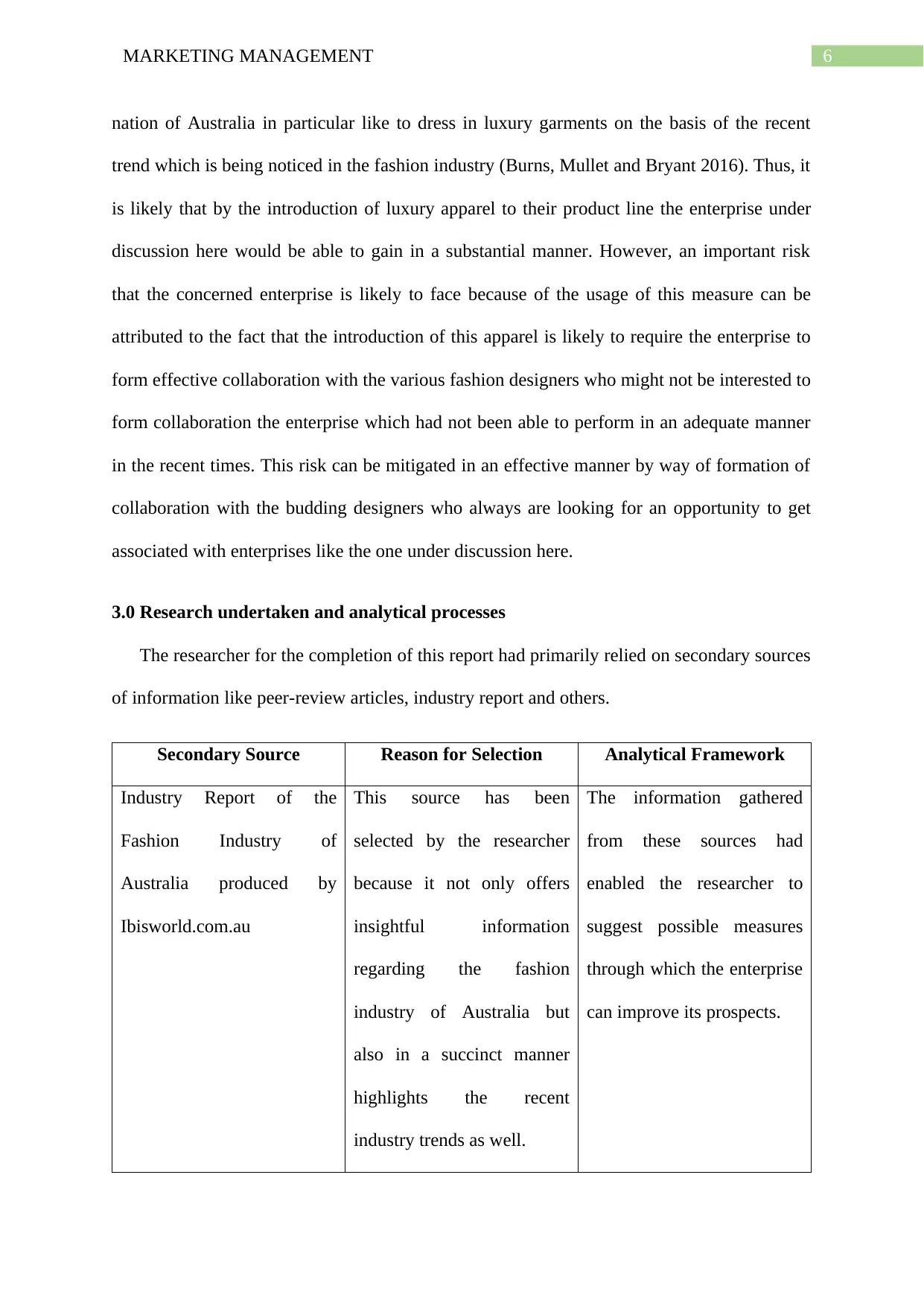
6MARKETING MANAGEMENT
nation of Australia in particular like to dress in luxury garments on the basis of the recent
trend which is being noticed in the fashion industry (Burns, Mullet and Bryant 2016). Thus, it
is likely that by the introduction of luxury apparel to their product line the enterprise under
discussion here would be able to gain in a substantial manner. However, an important risk
that the concerned enterprise is likely to face because of the usage of this measure can be
attributed to the fact that the introduction of this apparel is likely to require the enterprise to
form effective collaboration with the various fashion designers who might not be interested to
form collaboration the enterprise which had not been able to perform in an adequate manner
in the recent times. This risk can be mitigated in an effective manner by way of formation of
collaboration with the budding designers who always are looking for an opportunity to get
associated with enterprises like the one under discussion here.
3.0 Research undertaken and analytical processes
The researcher for the completion of this report had primarily relied on secondary sources
of information like peer-review articles, industry report and others.
Secondary Source Reason for Selection Analytical Framework
Industry Report of the
Fashion Industry of
Australia produced by
Ibisworld.com.au
This source has been
selected by the researcher
because it not only offers
insightful information
regarding the fashion
industry of Australia but
also in a succinct manner
highlights the recent
industry trends as well.
The information gathered
from these sources had
enabled the researcher to
suggest possible measures
through which the enterprise
can improve its prospects.
nation of Australia in particular like to dress in luxury garments on the basis of the recent
trend which is being noticed in the fashion industry (Burns, Mullet and Bryant 2016). Thus, it
is likely that by the introduction of luxury apparel to their product line the enterprise under
discussion here would be able to gain in a substantial manner. However, an important risk
that the concerned enterprise is likely to face because of the usage of this measure can be
attributed to the fact that the introduction of this apparel is likely to require the enterprise to
form effective collaboration with the various fashion designers who might not be interested to
form collaboration the enterprise which had not been able to perform in an adequate manner
in the recent times. This risk can be mitigated in an effective manner by way of formation of
collaboration with the budding designers who always are looking for an opportunity to get
associated with enterprises like the one under discussion here.
3.0 Research undertaken and analytical processes
The researcher for the completion of this report had primarily relied on secondary sources
of information like peer-review articles, industry report and others.
Secondary Source Reason for Selection Analytical Framework
Industry Report of the
Fashion Industry of
Australia produced by
Ibisworld.com.au
This source has been
selected by the researcher
because it not only offers
insightful information
regarding the fashion
industry of Australia but
also in a succinct manner
highlights the recent
industry trends as well.
The information gathered
from these sources had
enabled the researcher to
suggest possible measures
through which the enterprise
can improve its prospects.
Paraphrase This Document
Need a fresh take? Get an instant paraphrase of this document with our AI Paraphraser
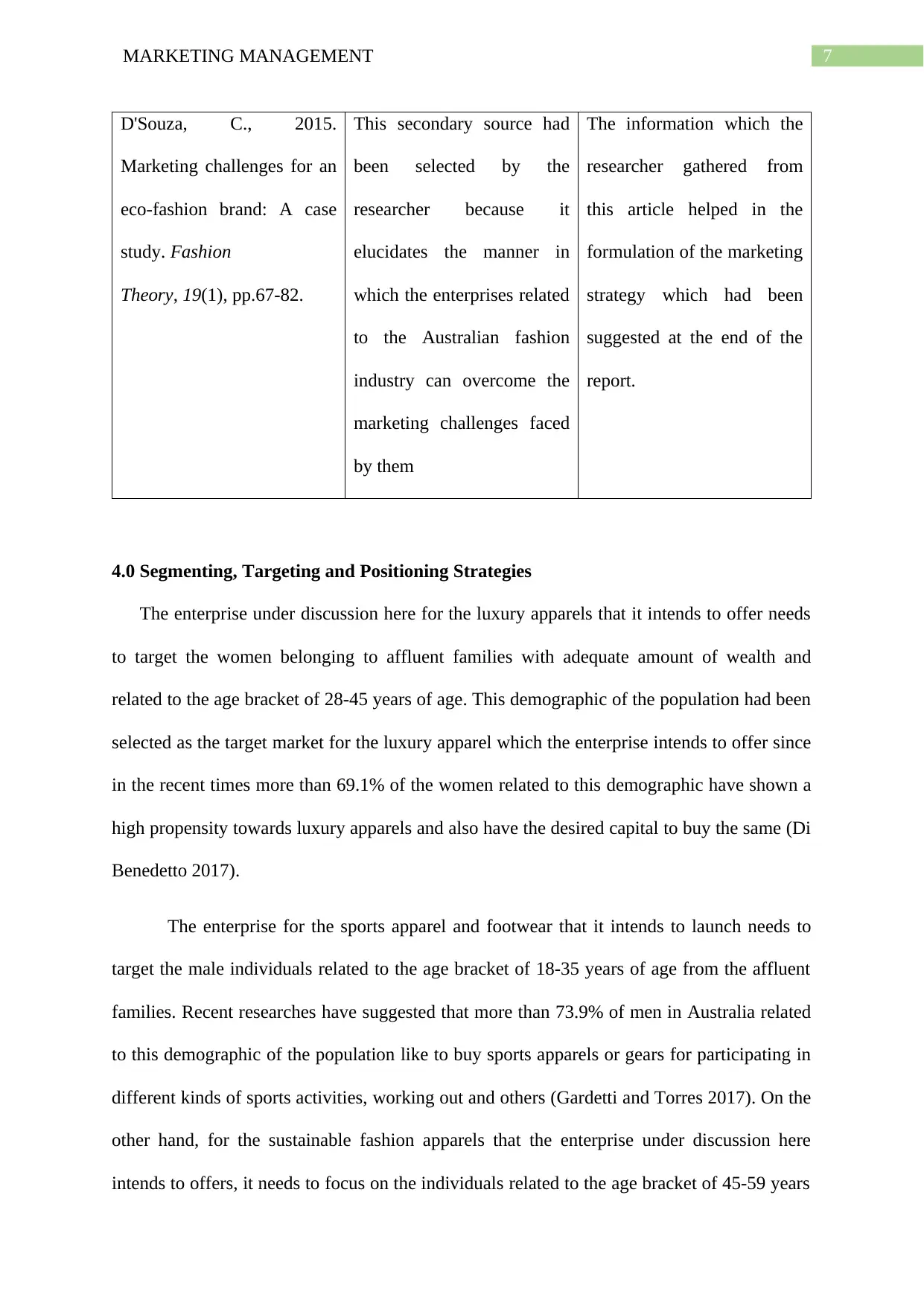
7MARKETING MANAGEMENT
D'Souza, C., 2015.
Marketing challenges for an
eco-fashion brand: A case
study. Fashion
Theory, 19(1), pp.67-82.
This secondary source had
been selected by the
researcher because it
elucidates the manner in
which the enterprises related
to the Australian fashion
industry can overcome the
marketing challenges faced
by them
The information which the
researcher gathered from
this article helped in the
formulation of the marketing
strategy which had been
suggested at the end of the
report.
4.0 Segmenting, Targeting and Positioning Strategies
The enterprise under discussion here for the luxury apparels that it intends to offer needs
to target the women belonging to affluent families with adequate amount of wealth and
related to the age bracket of 28-45 years of age. This demographic of the population had been
selected as the target market for the luxury apparel which the enterprise intends to offer since
in the recent times more than 69.1% of the women related to this demographic have shown a
high propensity towards luxury apparels and also have the desired capital to buy the same (Di
Benedetto 2017).
The enterprise for the sports apparel and footwear that it intends to launch needs to
target the male individuals related to the age bracket of 18-35 years of age from the affluent
families. Recent researches have suggested that more than 73.9% of men in Australia related
to this demographic of the population like to buy sports apparels or gears for participating in
different kinds of sports activities, working out and others (Gardetti and Torres 2017). On the
other hand, for the sustainable fashion apparels that the enterprise under discussion here
intends to offers, it needs to focus on the individuals related to the age bracket of 45-59 years
D'Souza, C., 2015.
Marketing challenges for an
eco-fashion brand: A case
study. Fashion
Theory, 19(1), pp.67-82.
This secondary source had
been selected by the
researcher because it
elucidates the manner in
which the enterprises related
to the Australian fashion
industry can overcome the
marketing challenges faced
by them
The information which the
researcher gathered from
this article helped in the
formulation of the marketing
strategy which had been
suggested at the end of the
report.
4.0 Segmenting, Targeting and Positioning Strategies
The enterprise under discussion here for the luxury apparels that it intends to offer needs
to target the women belonging to affluent families with adequate amount of wealth and
related to the age bracket of 28-45 years of age. This demographic of the population had been
selected as the target market for the luxury apparel which the enterprise intends to offer since
in the recent times more than 69.1% of the women related to this demographic have shown a
high propensity towards luxury apparels and also have the desired capital to buy the same (Di
Benedetto 2017).
The enterprise for the sports apparel and footwear that it intends to launch needs to
target the male individuals related to the age bracket of 18-35 years of age from the affluent
families. Recent researches have suggested that more than 73.9% of men in Australia related
to this demographic of the population like to buy sports apparels or gears for participating in
different kinds of sports activities, working out and others (Gardetti and Torres 2017). On the
other hand, for the sustainable fashion apparels that the enterprise under discussion here
intends to offers, it needs to focus on the individuals related to the age bracket of 45-59 years
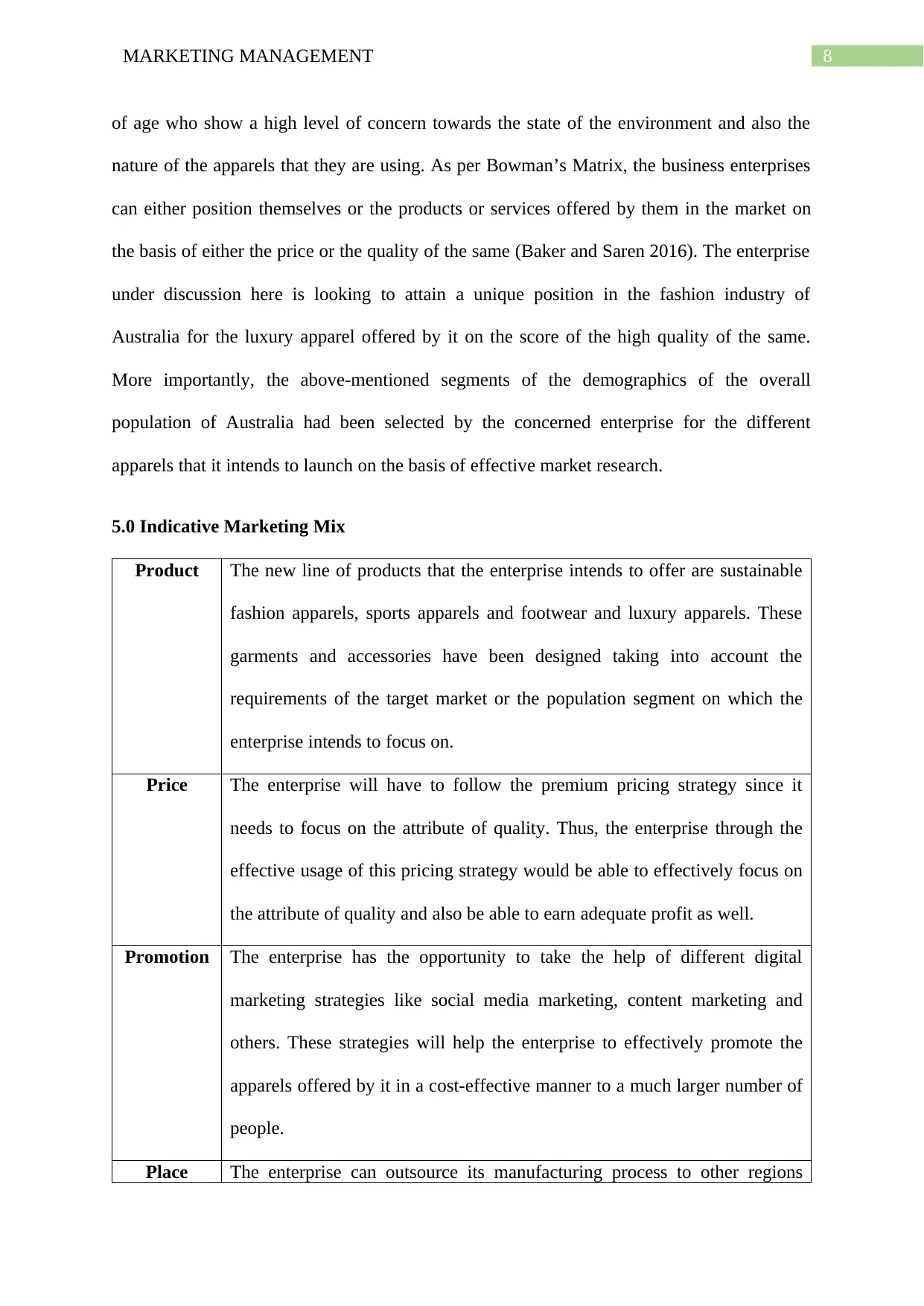
8MARKETING MANAGEMENT
of age who show a high level of concern towards the state of the environment and also the
nature of the apparels that they are using. As per Bowman’s Matrix, the business enterprises
can either position themselves or the products or services offered by them in the market on
the basis of either the price or the quality of the same (Baker and Saren 2016). The enterprise
under discussion here is looking to attain a unique position in the fashion industry of
Australia for the luxury apparel offered by it on the score of the high quality of the same.
More importantly, the above-mentioned segments of the demographics of the overall
population of Australia had been selected by the concerned enterprise for the different
apparels that it intends to launch on the basis of effective market research.
5.0 Indicative Marketing Mix
Product The new line of products that the enterprise intends to offer are sustainable
fashion apparels, sports apparels and footwear and luxury apparels. These
garments and accessories have been designed taking into account the
requirements of the target market or the population segment on which the
enterprise intends to focus on.
Price The enterprise will have to follow the premium pricing strategy since it
needs to focus on the attribute of quality. Thus, the enterprise through the
effective usage of this pricing strategy would be able to effectively focus on
the attribute of quality and also be able to earn adequate profit as well.
Promotion The enterprise has the opportunity to take the help of different digital
marketing strategies like social media marketing, content marketing and
others. These strategies will help the enterprise to effectively promote the
apparels offered by it in a cost-effective manner to a much larger number of
people.
Place The enterprise can outsource its manufacturing process to other regions
of age who show a high level of concern towards the state of the environment and also the
nature of the apparels that they are using. As per Bowman’s Matrix, the business enterprises
can either position themselves or the products or services offered by them in the market on
the basis of either the price or the quality of the same (Baker and Saren 2016). The enterprise
under discussion here is looking to attain a unique position in the fashion industry of
Australia for the luxury apparel offered by it on the score of the high quality of the same.
More importantly, the above-mentioned segments of the demographics of the overall
population of Australia had been selected by the concerned enterprise for the different
apparels that it intends to launch on the basis of effective market research.
5.0 Indicative Marketing Mix
Product The new line of products that the enterprise intends to offer are sustainable
fashion apparels, sports apparels and footwear and luxury apparels. These
garments and accessories have been designed taking into account the
requirements of the target market or the population segment on which the
enterprise intends to focus on.
Price The enterprise will have to follow the premium pricing strategy since it
needs to focus on the attribute of quality. Thus, the enterprise through the
effective usage of this pricing strategy would be able to effectively focus on
the attribute of quality and also be able to earn adequate profit as well.
Promotion The enterprise has the opportunity to take the help of different digital
marketing strategies like social media marketing, content marketing and
others. These strategies will help the enterprise to effectively promote the
apparels offered by it in a cost-effective manner to a much larger number of
people.
Place The enterprise can outsource its manufacturing process to other regions
⊘ This is a preview!⊘
Do you want full access?
Subscribe today to unlock all pages.

Trusted by 1+ million students worldwide
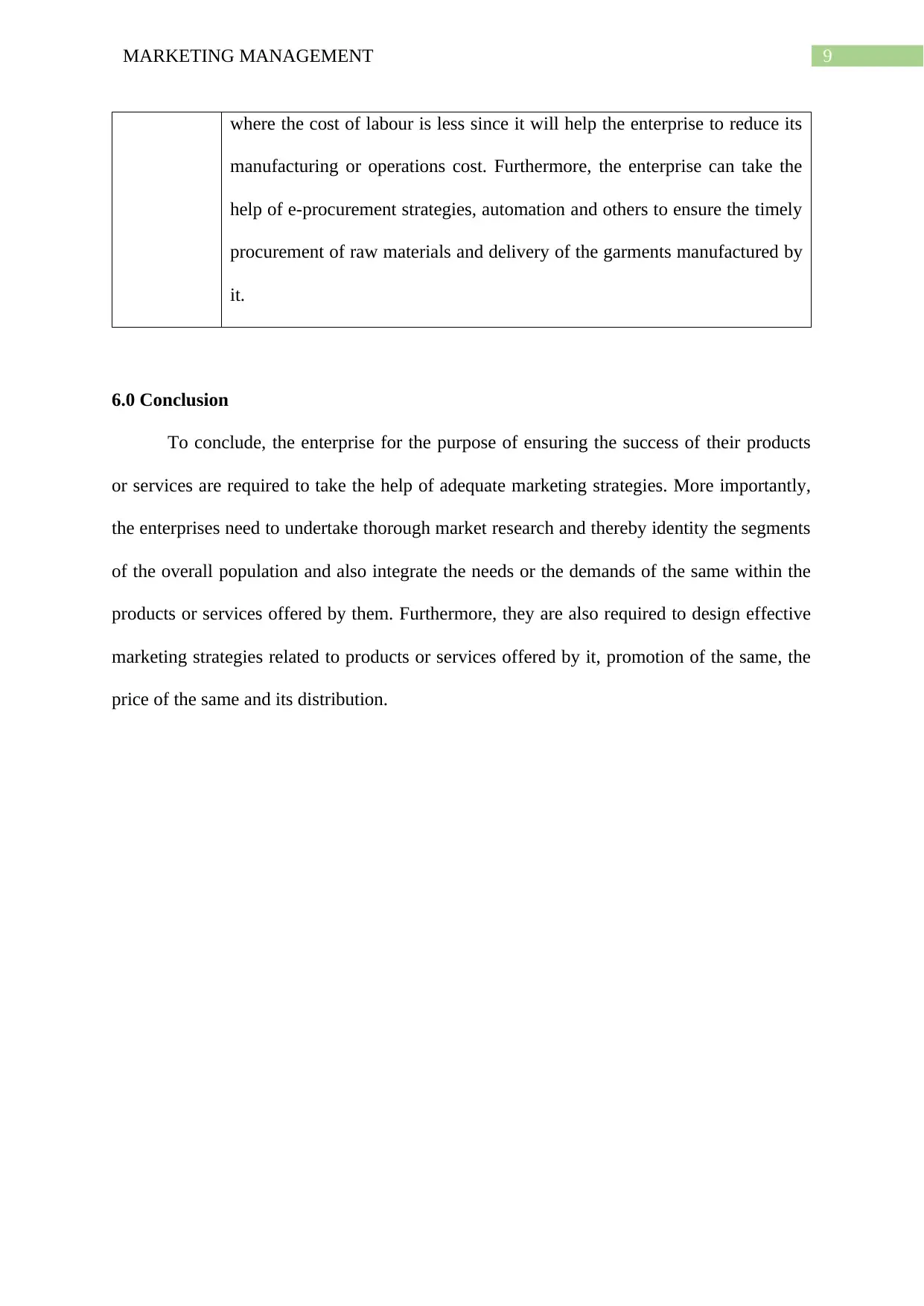
9MARKETING MANAGEMENT
where the cost of labour is less since it will help the enterprise to reduce its
manufacturing or operations cost. Furthermore, the enterprise can take the
help of e-procurement strategies, automation and others to ensure the timely
procurement of raw materials and delivery of the garments manufactured by
it.
6.0 Conclusion
To conclude, the enterprise for the purpose of ensuring the success of their products
or services are required to take the help of adequate marketing strategies. More importantly,
the enterprises need to undertake thorough market research and thereby identity the segments
of the overall population and also integrate the needs or the demands of the same within the
products or services offered by them. Furthermore, they are also required to design effective
marketing strategies related to products or services offered by it, promotion of the same, the
price of the same and its distribution.
where the cost of labour is less since it will help the enterprise to reduce its
manufacturing or operations cost. Furthermore, the enterprise can take the
help of e-procurement strategies, automation and others to ensure the timely
procurement of raw materials and delivery of the garments manufactured by
it.
6.0 Conclusion
To conclude, the enterprise for the purpose of ensuring the success of their products
or services are required to take the help of adequate marketing strategies. More importantly,
the enterprises need to undertake thorough market research and thereby identity the segments
of the overall population and also integrate the needs or the demands of the same within the
products or services offered by them. Furthermore, they are also required to design effective
marketing strategies related to products or services offered by it, promotion of the same, the
price of the same and its distribution.
Paraphrase This Document
Need a fresh take? Get an instant paraphrase of this document with our AI Paraphraser
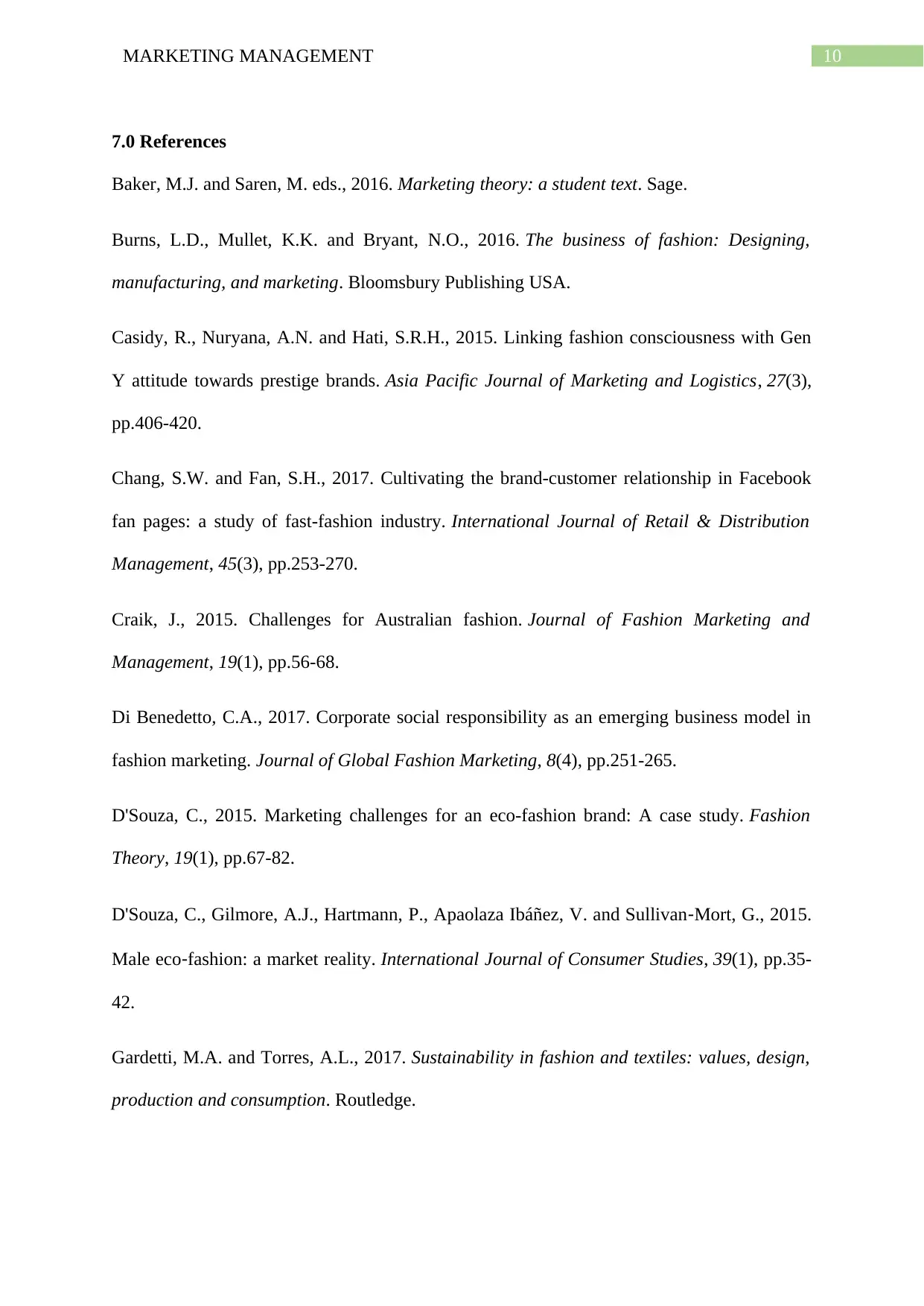
10MARKETING MANAGEMENT
7.0 References
Baker, M.J. and Saren, M. eds., 2016. Marketing theory: a student text. Sage.
Burns, L.D., Mullet, K.K. and Bryant, N.O., 2016. The business of fashion: Designing,
manufacturing, and marketing. Bloomsbury Publishing USA.
Casidy, R., Nuryana, A.N. and Hati, S.R.H., 2015. Linking fashion consciousness with Gen
Y attitude towards prestige brands. Asia Pacific Journal of Marketing and Logistics, 27(3),
pp.406-420.
Chang, S.W. and Fan, S.H., 2017. Cultivating the brand-customer relationship in Facebook
fan pages: a study of fast-fashion industry. International Journal of Retail & Distribution
Management, 45(3), pp.253-270.
Craik, J., 2015. Challenges for Australian fashion. Journal of Fashion Marketing and
Management, 19(1), pp.56-68.
Di Benedetto, C.A., 2017. Corporate social responsibility as an emerging business model in
fashion marketing. Journal of Global Fashion Marketing, 8(4), pp.251-265.
D'Souza, C., 2015. Marketing challenges for an eco-fashion brand: A case study. Fashion
Theory, 19(1), pp.67-82.
D'Souza, C., Gilmore, A.J., Hartmann, P., Apaolaza Ibáñez, V. and Sullivan‐Mort, G., 2015.
Male eco‐fashion: a market reality. International Journal of Consumer Studies, 39(1), pp.35-
42.
Gardetti, M.A. and Torres, A.L., 2017. Sustainability in fashion and textiles: values, design,
production and consumption. Routledge.
7.0 References
Baker, M.J. and Saren, M. eds., 2016. Marketing theory: a student text. Sage.
Burns, L.D., Mullet, K.K. and Bryant, N.O., 2016. The business of fashion: Designing,
manufacturing, and marketing. Bloomsbury Publishing USA.
Casidy, R., Nuryana, A.N. and Hati, S.R.H., 2015. Linking fashion consciousness with Gen
Y attitude towards prestige brands. Asia Pacific Journal of Marketing and Logistics, 27(3),
pp.406-420.
Chang, S.W. and Fan, S.H., 2017. Cultivating the brand-customer relationship in Facebook
fan pages: a study of fast-fashion industry. International Journal of Retail & Distribution
Management, 45(3), pp.253-270.
Craik, J., 2015. Challenges for Australian fashion. Journal of Fashion Marketing and
Management, 19(1), pp.56-68.
Di Benedetto, C.A., 2017. Corporate social responsibility as an emerging business model in
fashion marketing. Journal of Global Fashion Marketing, 8(4), pp.251-265.
D'Souza, C., 2015. Marketing challenges for an eco-fashion brand: A case study. Fashion
Theory, 19(1), pp.67-82.
D'Souza, C., Gilmore, A.J., Hartmann, P., Apaolaza Ibáñez, V. and Sullivan‐Mort, G., 2015.
Male eco‐fashion: a market reality. International Journal of Consumer Studies, 39(1), pp.35-
42.
Gardetti, M.A. and Torres, A.L., 2017. Sustainability in fashion and textiles: values, design,
production and consumption. Routledge.
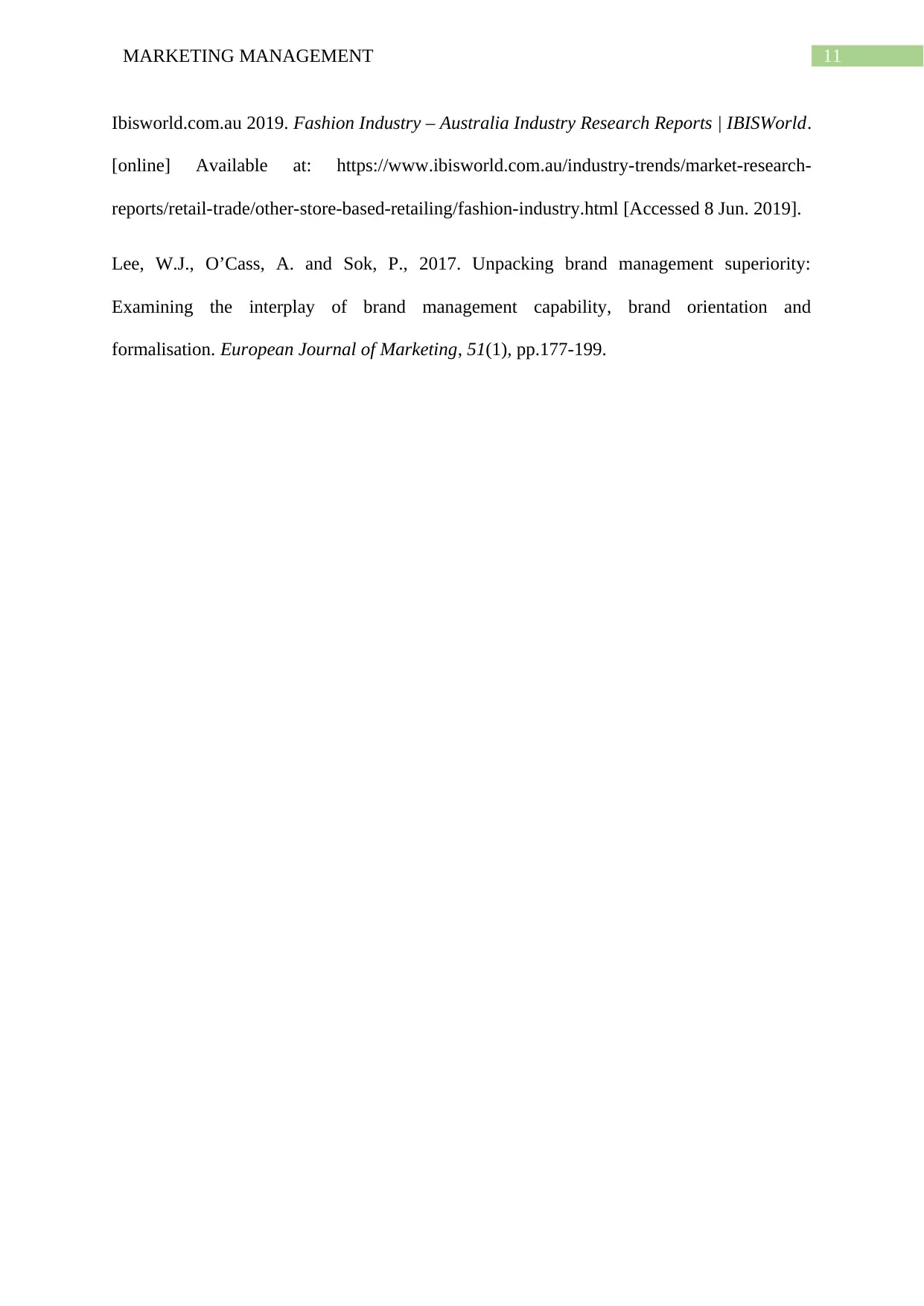
11MARKETING MANAGEMENT
Ibisworld.com.au 2019. Fashion Industry – Australia Industry Research Reports | IBISWorld.
[online] Available at: https://www.ibisworld.com.au/industry-trends/market-research-
reports/retail-trade/other-store-based-retailing/fashion-industry.html [Accessed 8 Jun. 2019].
Lee, W.J., O’Cass, A. and Sok, P., 2017. Unpacking brand management superiority:
Examining the interplay of brand management capability, brand orientation and
formalisation. European Journal of Marketing, 51(1), pp.177-199.
Ibisworld.com.au 2019. Fashion Industry – Australia Industry Research Reports | IBISWorld.
[online] Available at: https://www.ibisworld.com.au/industry-trends/market-research-
reports/retail-trade/other-store-based-retailing/fashion-industry.html [Accessed 8 Jun. 2019].
Lee, W.J., O’Cass, A. and Sok, P., 2017. Unpacking brand management superiority:
Examining the interplay of brand management capability, brand orientation and
formalisation. European Journal of Marketing, 51(1), pp.177-199.
⊘ This is a preview!⊘
Do you want full access?
Subscribe today to unlock all pages.

Trusted by 1+ million students worldwide
1 out of 12
Related Documents
Your All-in-One AI-Powered Toolkit for Academic Success.
+13062052269
info@desklib.com
Available 24*7 on WhatsApp / Email
![[object Object]](/_next/static/media/star-bottom.7253800d.svg)
Unlock your academic potential
Copyright © 2020–2025 A2Z Services. All Rights Reserved. Developed and managed by ZUCOL.





